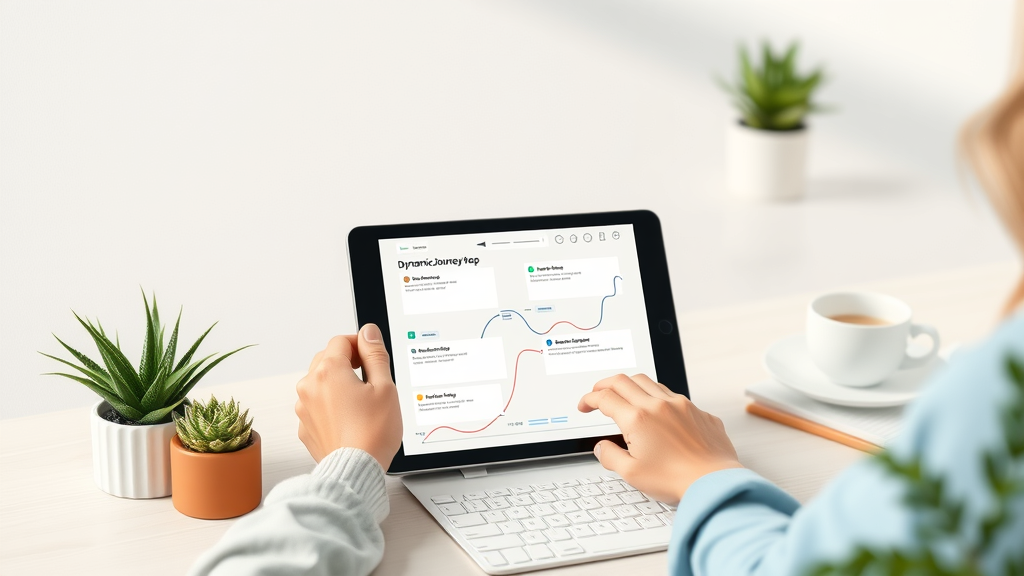Did you know that companies leveraging data-driven marketing are six times more likely to be profitable year-over-year? The modern marketing landscape has been reinvented by big data, smart analytics, and customer-centric strategies – and those who master these secrets consistently outshine their competition. In this comprehensive guide, you’ll uncover exactly how data transforms marketing work into measurable results, why leading brands invest so heavily in these strategies, and how you can start applying actionable tactics to amplify your own marketing campaigns. If you want to see real impact and sustainable growth in your digital marketing, read on – these are the secrets you can’t afford to miss. The Power of Data-Driven Marketing: Surprising Insights to Start Your Journey "Companies leveraging data-driven marketing are six times more likely to be profitable year-over-year." The impact of data-driven marketing is revolutionizing the field. Instead of relying on guesswork or intuition, today’s marketing teams use big data and analytics to inform every major decision. This approach not only improves the accuracy of marketing strategies but also uncovers surprising insights. For example, companies that use marketing analytics and digital dashboards can spot emerging trends, respond swiftly to customer needs, and create hyper-targeted campaigns with significantly higher conversion rates. The shift to evidence-based marketing has played a crucial role in increasing brand awareness, fine-tuning customer experience, and ultimately driving consistent long-term profitability. As businesses collect more customer data from sources like social media, websites, and apps, they’re empowered to refine every aspect of their marketing campaign. The result? A tailored approach to marketing that leads to meaningful engagement and higher ROI. When you let data guide your strategy, every touchpoint—from social media ads to email campaigns—becomes an opportunity for resonance, relevance, and measurable return on investment. Embracing data-driven marketing is no longer an option—it's the new rule for success in modern marketing. Maximize Your Learning: What You’ll Gain from Data-Driven Marketing Strategies Understand the core concepts behind data-driven marketing Explore how big data and analytics transform digital marketing Discover actionable marketing strategies powered by data Uncover innovative applications within marketing management Master metrics and predictive analytics to optimize customer experience By diving into data-driven marketing strategies , you will not only grasp the foundational concepts that power this transformative approach, but also see how big data enhances digital marketing efforts. This guide will provide you with real strategies you can use, such as optimizing campaigns based on actionable insights and applying predictive analytics to anticipate customer behavior. Whether you’re a marketing manager looking to elevate your team’s performance or a business owner seeking efficient digital marketing solutions, these lessons offer practical value for every stage of your journey. In today’s connected world, the power of data in marketing can’t be overstated. This article will show you exactly how analytics can guide you from data collection to audience targeting, delivering more personalized customer experiences and maximizing the impact of your marketing work. You’ll uncover innovative techniques used by global brands, and learn how to measure and continually refine your outcomes for ongoing growth. Mastering these concepts means learning not only to analyze, but to act on data. With a clear understanding of the methods and tools discussed in this comprehensive guide, you’ll be able to sharpen your marketing strategies , enhance your digital campaigns, and stay one step ahead in the dynamic world of driven marketing. What is Meant by Data-Driven Marketing? Essential Concepts to Know Defining Data-Driven Marketing and Its Role in Business Growth Data-driven marketing is the practice of harnessing big data —collecting, processing, and analyzing vast amounts of information—to inform every aspect of your marketing strategy. By letting data guide your decisions, you remove uncertainty and base campaigns on proven insights rather than speculation. For example, gathering customer data across multiple touchpoints allows marketing managers to understand the target audience’s behavior, preferences, and motivations on a granular level. This evidence-based approach to marketing lets organizations anticipate trends, allocate budgets more effectively, and optimize the ROI of every marketing campaign. Businesses that successfully implement data-driven marketing notice accelerated growth. Evidence-based strategy means you’re better prepared to react to shifting market demands, address customer pain points, and personalize communication. In turn, this creates more impactful customer relations and fosters lasting loyalty. As chief marketing officers and their teams focus on data collection and analysis, they build a feedback loop that continually improves all marketing work—making decisions that drive real, measurable business success. Key Differences: Data-Driven Marketing vs. Traditional Marketing The divide between data-driven marketing and traditional marketing lies in the foundation of decision-making. Traditional marketing relies on intuition, broad audience assumptions, and fixed messages delivered through mass media. In contrast, driven marketing depends on actionable customer data, market analytics, and continuous testing. By using big data to inform their choices, modern marketers design highly targeted campaigns that reach the right audience at the optimal time with content tailored to individual preferences. This shift away from conventional methods greatly increases efficiency and effectiveness. While traditional marketing efforts risk becoming outdated as consumer behavior changes, data-driven marketers pivot quickly by analyzing metrics in real time and refining strategies as needed. Ultimately, this approach minimizes wasted ad spend and maximizes the impact of your marketing team’s work, positioning your brand ahead of competitors. Data-driven marketing not only elevates campaign performance but also transforms how marketing managers plan, execute, and measure success. Instead of relying on limited information, they assess diverse data sources, breaking down data silos for a unified approach that aligns with business objectives and drives measurable growth. The Role of Big Data in Modern Marketing Strategies Big data plays a pivotal role in shaping the modern marketing strategy. Today’s businesses gather information from countless data sources, such as social media engagement, website interactions, CRM systems, and digital advertising platforms. By analyzing this data at scale, organizations can identify patterns, forecast consumer behavior, and optimize campaigns for maximum impact. Big data not only amplifies the effectiveness of individual marketing campaigns but also influences long-term strategies, helping brands adapt quickly as markets evolve. Integrated marketing analytics platforms and predictive analytics tools enable teams to process vast datasets efficiently, uncover trends, and make informed decisions based on data rather than assumptions. This means companies can create more engaging customer experiences, improve retention rates, and increase brand awareness by delivering the right message to the right person at the right time. Ultimately, the role of big data in marketing is to empower businesses with the knowledge to navigate the complexities of the digital age. By utilizing advanced analytics, organizations foster a culture of continuous learning and improvement, leading to sustainable business growth and enhanced customer loyalty in the ever-evolving landscape of driven marketing. Data-driven marketing uses sophisticated analytics and big data insights to enhance digital marketing efforts, refine marketing strategies, and personalize the customer experience. Unlike traditional marketing, it relies on actionable metrics and evidence-based decisions to drive growth. Data-Driven Marketing Fundamentals: Foundations for Every Marketing Manager Understanding the Marketing Strategy Behind Data-Driven Success A successful marketing strategy in today’s world is built on a foundation of data, analysis, and targeted action. For every marketing manager , shifting to a data-driven approach means establishing clear objectives, aligning campaigns with business goals, and continuously using data to inform each decision. Rather than executing set-and-forget tactics, your team evaluates each stage of the customer journey, identifies key touchpoints, and crafts engaging experiences based on actionable insights from collected data. Modern marketing teams prioritize the consistent measurement of performance—assessing what works, what doesn’t, and why. By pairing an agile mindset with data-backed experimentation, managers can quickly refine or pivot campaigns when new information emerges. As a result, marketing decisions become both smarter and more responsive, ensuring every marketing campaign is optimized for maximum impact. Ultimately, data-driven marketing strategy transforms managers into proactive leaders who are equipped to boost customer satisfaction, brand awareness, and long-term profitability. Embracing these fundamentals ensures you continuously outpace competitors in a rapidly shifting digital marketing environment. How Marketing Analytics Elevate Decision-Making At the heart of every effective marketing strategy are robust analytics tools and a systematic approach to data interpretation. Marketing analytics enable teams to track campaign performance across channels, compare segmented customer responses, and identify the most productive channels for return on investment. Instead of relying solely on intuition, a marketing manager uses these insights to develop campaigns that are precisely tailored to audience needs. For example, marketing analytics can reveal which messaging resonates best with specific customer segments, how long users engage with your content, or which digital marketing platforms deliver the best conversion rates. Such insights empower teams to refine their campaigns, double down on what works, and scale back on tactics that waste budget. This process is ongoing, with every new round of data collection informing incremental improvements. In data-driven marketing, analytics is more than just measurement—it’s a catalyst for better decisions and bigger results. Data-driven managers who invest in analytics outperform those who don’t, fueling innovative marketing strategies that drive measurable growth and build lasting customer loyalty. The Importance of Data in Marketing Transformation The adoption of data in marketing has transformed the industry. Today, marketers use data to inform everything from campaign creative to audience targeting, brand messaging, and channel selection. By analyzing data from a wide range of sources, brands gain a more comprehensive understanding of customer motivations and behaviors, which in turn leads to more impactful and personalized experiences. This transformation is ongoing. New technologies for collecting and analyzing data on customer engagement, sentiment, and purchase trends are constantly emerging, providing marketers with more precise tools than ever before. The importance of data in marketing transformation cannot be overstated—it enables brands to act quickly, experiment often, and continually refine their approach to meet ever-evolving customer expectations. Embracing this data-first mindset positions marketing teams to achieve breakthroughs in efficiency, creativity, and results. As data becomes the backbone of all marketing activity, businesses that fully integrate these insights into their marketing teams and digital marketing strategies will be best positioned to lead and innovate. Core Elements of Driven Marketing: Transforming Insights into Action Collecting and Integrating Big Data for Data-Driven Marketing The collection and integration of big data form the backbone of any driven marketing initiative. Businesses today harvest data from an ever-growing list of sources: website analytics, email engagement, social media interactions, point-of-sale systems, and even IoT-enabled devices. To break down data silos and create a unified customer view, marketers must deploy advanced integration tools and cloud-based platforms that centralize this wealth of information. Ensuring the integrity and accessibility of customer data is crucial. Clean, accurate data sets the stage for actionable insights and better marketing decisions. By integrating multiple data sources, teams gain a more complete picture, allowing for detailed segmentation and precise targeting. This foundational work enables businesses to pivot from a generalized, traditional marketing approach to a dynamic, responsive, and highly relevant strategy driven by real-time analytics. When big data flows efficiently and securely between departments—without the constraints of data silos—marketing teams can coordinate cross-channel campaigns, personalize interactions at scale, and quickly adapt to feedback. The end result: stronger customer experiences, more effective marketing campaigns, and measurable business growth. Using Predictive Analytics to Optimize Your Marketing Strategy Predictive analytics is a game-changing tool for marketing managers looking to stay ahead of the competition. By analyzing historical data, machine learning algorithms can forecast future customer behaviors, purchase patterns, and market demands. These predictions empower teams to proactively allocate resources, craft timely offers, and design campaigns that are both relevant and cost-effective. The integration of predictive analytics into your marketing strategy means making smarter use of every marketing dollar spent. Leading brands like Netflix and Amazon rely heavily on these tools to recommend content, anticipate customer needs, and deliver hyper-personalized experiences. As predictive analytics become more sophisticated, even smaller firms can use readily available tools to level the playing field and compete with industry giants. The key to optimizing your marketing strategies with predictive analytics lies in testing, measurement, and continued refinement. By tracking which forecasts prove accurate, marketing teams learn which signals predict high-value outcomes, continually improving future marketing campaigns and maximizing return on investment. Personalizing the Customer Experience Through Data Personalization is at the core of modern data-driven marketing. By drawing from detailed customer data , businesses craft individualized experiences that resonate with each customer. From email content tailored to prior purchases, to curated product recommendations and targeted social media ads, every marketing message is shaped to meet a specific need. This focus on personalization has a profound effect on customer satisfaction and loyalty. Research shows that 80% of consumers are more likely to do business with brands that offer personalized experiences. Marketing teams use analytics to customize content in real time, ensuring interactions are always relevant and valuable. Data-driven marketing moves beyond simple segmentation to true one-to-one engagement, transforming each interaction into an opportunity to build trust and deepen customer relationships. The more personalized the experience, the greater the impact on engagement rates, repeat sales, and lifelong advocacy for your brand. The Data-Driven Marketing Process: Step-by-Step Guide for Success Gather data from multiple sources Analyze marketing data for actionable insights Refine your digital marketing plan based on analytics Deploy targeted, measurable campaigns Track performance and optimize continuously To implement data-driven marketing successfully, it’s essential to follow a systematic process. First, gather data from a wide variety of sources, including online behavior, CRM systems, social media channels, and offline interactions. By consolidating this data and removing silos, your marketing manager lays the groundwork for powerful analysis. Next, tools like marketing analytics platforms help you transform raw data into actionable insights. Use these insights to refine your digital marketing plan, focusing on what works best for your audience. Then, deploy tailored marketing campaigns across relevant channels, ensuring each message is targeted, measurable, and aligned with your business goals. Finally, track performance rigorously and optimize your strategies based on real-time results. This cycle of measurement and refinement is what keeps driven marketing strategies adaptive, effective, and primed for long-term success. By embedding these steps into your approach, you’ll empower your team to deliver outstanding results and stay ahead of the competition. Integrating Big Data into Your Digital Marketing Strategy How Big Data Powers Advanced Marketing Analytics Harnessing the limitless potential of big data is fundamental for businesses committed to smart, competitive marketing. Advanced analytics platforms collect and process massive amounts of structured and unstructured data, turning it into actionable business intelligence that fuels every digital marketing initiative. Marketers then use this intelligence to understand shifting market flows, detect patterns in customer behavior, and adapt rapidly to consumer needs. The synergy between big data and analytics allows organizations to break new ground in segmentation and targeting. For example, dynamic dashboards visualize campaign results in real time, providing the level of clarity that makes rapid optimization possible. As your marketing team works with increasingly complex data streams, the ability to extract meaningful insights from this information becomes a unique competitive advantage. Big data not only enhances efficiency but also propels innovation in customer experience and engagement. By managing vast and varied data sets, brands can experiment with new digital marketing tactics and quickly scale up those that deliver results. The bottom line—big data powers the next generation of marketing strategies, transforming raw information into profit-driving decisions. Top Digital Marketing Tools for Data Collection and Analysis Tool Purpose Key Features Google Analytics Web analytics Traffic insights, conversion tracking HubSpot CRM & marketing automation Lead scoring, campaign ROI Tableau Data visualization Interactive dashboards Salesforce Marketing Cloud Email marketing Customer journeys, segmentation The success of a data-driven marketing strategy hinges on selecting the right tools for data collection and analysis. Platforms like Google Analytics, HubSpot, Tableau, and Salesforce Marketing Cloud are industry-leading solutions that streamline how organizations gather, interpret, and act on complex data. Each tool brings a unique set of features—from web and CRM analytics to sophisticated campaign management and data visualization dashboards—enabling marketing teams to convert raw data into actionable plans. These platforms facilitate seamless integration with other systems, break down data silos, and enhance collaboration across marketing teams. By leveraging the full power of these digital marketing tools, brands ensure they stay ahead of trends, anticipate shifts in customer behavior, and deliver increasingly effective marketing campaigns that drive real business results. Real-World Examples: Data-Driven Marketing in Action How Netflix uses predictive analytics to recommend shows Coca-Cola’s personalized customer experience via digital marketing Amazon’s targeting strategies rooted in data-driven marketing Netflix is perhaps the most iconic example of data-driven marketing at work. The company leverages sophisticated predictive analytics to analyze millions of user interactions and viewing histories. With this data, Netflix recommends shows tailored specifically to each user’s preferences and viewing behavior, driving engagement and customer loyalty. Coca-Cola utilizes digital marketing to create personalized experiences for its customers around the globe. By collecting and analyzing purchase data, social media interactions, and event participation, the company crafts marketing campaigns that resonate with regional trends and customer segments, fostering deeper brand connections. Amazon is renowned for its targeting strategies based on customer data analysis. By meticulously tracking browsing habits, previous purchases, and even wish-list activity, the platform continuously personalizes the customer journey. Every suggestion, promotion, and notification is tuned to individual preferences, turning data-driven marketing into an engine for remarkable business growth. From Metrics to Mastery: Measuring Success in Data-Driven Marketing Key Performance Indicators for Data-Driven Marketers Success in data-driven marketing comes down to clearly defined key performance indicators (KPIs) . Unlike traditional marketing, which often leans on broad estimations, data-driven strategies demand precise benchmarks—such as conversion rate, customer lifetime value, return on investment, and engagement metrics across channels. The right KPIs are customized for each campaign and business goal. For example, a digital marketing team might track website traffic and dwell time to measure content effectiveness, or use lead scoring and nurture rates to assess CRM and email performance. By focusing on a select group of meaningful indicators, marketing teams can pinpoint what drives growth and adjust strategies accordingly. Ongoing KPI measurement not only keeps marketing campaigns on-track, it also reveals hidden opportunities for innovation and improvement, pushing your brand toward deeper market penetration and revenue expansion. Implementing Continuous Improvement with Marketing Analytics Continuous improvement is at the heart of data-driven marketing. By regularly reviewing campaign data and performance analytics, marketing teams identify areas where they can enhance the customer experience, refine targeting strategies, and eliminate ineffective tactics. This approach is inherently agile: teams run experiments, gather results, and iterate quickly. Clear documentation of every improvement cycle builds a powerful feedback loop, making marketing teams nimbler and more innovative over time. Using sophisticated marketing analytics, companies achieve ongoing optimization, ensuring every marketing dollar delivers maximum possible value—and every campaign steadily increases in effectiveness. Predictive Analytics: The Game Changer in Data-Driven Marketing How Predictive Analytics Forecasts Customer Behavior Predictive analytics uses machine learning and big data algorithms to forecast what customers will do next—from which products they’ll buy, to when they’re likely to churn, to what messages will resonate most. By combining historical information with real-time inputs, marketers anticipate needs and deliver solutions before customers even realize they want them. This forecasting ability gives brands a major competitive edge, supporting proactive campaign design and smarter resource allocation. With predictive models, marketing teams can segment audiences with greater precision, target at-risk customers, and time promotions for maximum impact. Predictive analytics also revolutionizes the way managers set goals and measure progress, making long-term planning more reliable and results more sustainable. Integrating Predictive Analytics with Marketing Strategies Effective integration of predictive analytics into marketing strategies starts with clear objectives and high-quality data. Teams deploy predictive models across channels—email, digital advertising, social media—to optimize every interaction. Examples include recommending highly relevant products to individual customers, triggering retargeting ads based on website behavior, or identifying emerging trends early to guide content strategies. As predictive analytics platforms evolve, even smaller businesses can gain access to advanced capabilities, leveling the playing field with larger competitors. The secret to success lies in continual calibration: as predictive analytics highlight new opportunities or threats, teams must act quickly—adapting their marketing work, testing new hypotheses, and doubling down on data-backed strategies. FAQs About Data-Driven Marketing What is data-driven marketing? What are top examples of data-driven marketing strategies? How is big data used in digital marketing? How do marketing analytics and predictive analytics differ? Is data-driven marketing more effective than traditional marketing? What is data-driven marketing? Data-driven marketing refers to approaches that rely on data analysis and big data insights to inform and refine marketing strategies, resulting in more targeted, efficient, and measurable results. What are top examples of data-driven marketing strategies? Leading strategies include segmentation based on data, personalized email campaigns using customer data, predictive recommendations, dynamic pricing, and using real-time analytics from digital platforms for timely adjustments. How is big data used in digital marketing? Big data is used to analyze consumer behavior, segment audiences, personalize communications, anticipate trends, and optimize advertising for higher ROI. It enables brands to scale marketing efforts while maintaining relevance and precision. How do marketing analytics and predictive analytics differ? Marketing analytics focuses on measuring and optimizing current and past campaign performance, while predictive analytics uses that data to forecast future behaviors and outcomes. Both enhance the overall effectiveness of digital marketing strategies. Is data-driven marketing more effective than traditional marketing? Yes, data-driven marketing is generally more effective because it is based on actual customer data and measurable insights, enabling better targeting, personalization, and continuous optimization compared to traditional broad-based approaches. People Also Ask What is meant by data-driven marketing? Data-driven marketing refers to approaches that rely on data analysis and big data insights to inform and refine marketing strategies, resulting in more targeted, efficient, and measurable results. What is data drive marketing? Data drive marketing is the implementation of marketing tactics based on collected data, such as customer behavior or purchase history, to personalize marketing efforts and optimize outcomes. What is the data-driven marketing theory? The data-driven marketing theory revolves around the premise that every marketing action should be driven by actionable data, leveraging analytics and predictive insights to maximize ROI and improve marketing performance. What is data-driven content marketing? Data-driven content marketing leverages big data and analytics to inform content creation and distribution, ensuring messages resonate with audiences, improve engagement, and support overarching marketing strategies. Expert Perspectives: Quotes on Data-Driven Marketing and Big Data "Without data, you're just another person with an opinion." – W. Edwards Deming Achieving Long-Term Success with Data-Driven Marketing Stay updated on digital marketing technologies Encourage a culture of continuous learning in your marketing team Leverage predictive analytics for future campaigns Regularly assess customer experience for improvement Long-term success in data-driven marketing demands ongoing investment in technology, education, and experimentation. By keeping up with digital marketing trends, nurturing a learning-focused culture, and continually using analytics to refine strategy, your team ensures lasting competitive advantage and customer loyalty. Remember, the most successful marketing managers are those who turn lessons into action—constantly pushing their strategies further as new data becomes available. Let your marketing work evolve with the customer and the technology, and measurable success will follow. Start Implementing Data-Driven Marketing: Your Next Steps Take action: Assess your current data sources, invest in leading analytics tools, empower your marketing team with ongoing education, and start small—testing new strategies and measuring results. Begin today, and unlock the full potential of data-driven marketing for your business growth.











 Add Row
Add Row  Add
Add 





Write A Comment